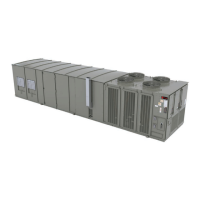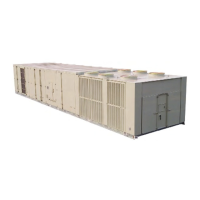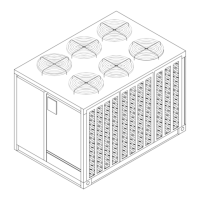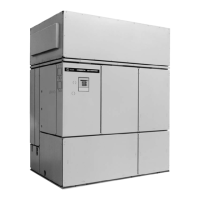110
RT-SVX063E-EN
Record this data on an “operator’s maintenance log”
like the one shown in , p. 134. If the operating
pressures indicate a refrigerant shortage, measure the
system superheat and system subcooling. For
guidelines, refer to .
IImmppoorrttaanntt:: Do not release refrigerant to the
atmosphere! If adding or removing
refrigerant is required, the service
technician must comply with all federal,
state and local laws. Refer to general
service bulletin MSCU-SB-1 (latest edition).
Heating Season
WWAARRNNIINNGG
HHaazzaarrddoouuss VVoollttaaggee!!
FFaaiilluurree ttoo ddiissccoonnnneecctt ppoowweerr bbeeffoorree sseerrvviicciinngg ccoouulldd
rreessuulltt iinn ddeeaatthh oorr sseerriioouuss iinnjjuurryy..
DDiissccoonnnneecctt aallll eelleeccttrriicc ppoowweerr,, iinncclluuddiinngg rreemmoottee
ddiissccoonnnneeccttss bbeeffoorree sseerrvviicciinngg.. FFoollllooww pprrooppeerr
lloocckkoouutt//ttaaggoouutt pprroocceedduurreess ttoo eennssuurree tthhee ppoowweerr
ccaann nnoott bbee iinnaaddvveerrtteennttllyy eenneerrggiizzeedd.. VVeerriiffyy tthhaatt nnoo
ppoowweerr iiss pprreesseenntt wwiitthh aa vvoollttmmeetteerr..
Before completing the following checks, turn the unit
OOFFFF and lock the main power disconnect switch open.
☐ Inspect the unit air filters. If necessary, clean or
replace them.
☐ Check supply fan motor bearings; repair or replace
the motor as necessary.
☐ Inspect both the main unit control panel and heat
section control box for loose electrical components
and terminal connections, as well as damaged wire
insulation. Make any necessary repairs.
☐ Gas units only - Check the heat exchanger(s) for any
corrosion, cracks, or holes.
☐ Gas units only - Check the combustion air blower
and venting system for dirt or blockage from
animals or insects. Clean as necessary.
☐ Gas units only - Check that burner, tubes, and
orifices are free of debris or blockage from insects.
☐ Check gas piping for leaks.
☐ Gas units only - Open the main gas valve and apply
power to the unit heating section; then initiate a
“Heat” test using the startup procedure described
in “Staged, Modulating, and Ultra Modulating,” p.
59.
WWAARRNNIINNGG
HHaazzaarrddoouuss GGaasseess aanndd FFllaammmmaabbllee
VVaappoorrss!!
FFaaiilluurree ttoo oobbsseerrvvee tthhee ffoolllloowwiinngg iinnssttrruuccttiioonnss
ccoouulldd rreessuulltt iinn eexxppoossuurree ttoo hhaazzaarrddoouuss ggaasseess,,
ffuueell ssuubbssttaanncceess,, oorr ssuubbssttaanncceess ffrroomm
iinnccoommpplleettee ccoommbbuussttiioonn,, wwhhiicchh ccoouulldd rreessuulltt iinn
ddeeaatthh oorr sseerriioouuss iinnjjuurryy.. TThhee ssttaattee ooff CCaalliiffoorrnniiaa
hhaass ddeetteerrmmiinneedd tthhaatt tthheessee ssuubbssttaanncceess mmaayy
ccaauussee ccaanncceerr,, bbiirrtthh ddeeffeeccttss,, oorr ootthheerr
rreepprroodduuccttiivvee hhaarrmm..
IImmpprrooppeerr iinnssttaallllaattiioonn,, aaddjjuussttmmeenntt,, aalltteerraattiioonn,,
sseerrvviiccee oorr uussee ooff tthhiiss pprroodduucctt ccoouulldd ccaauussee
ffllaammmmaabbllee mmiixxttuurreess oorr lleeaadd ttoo eexxcceessssiivvee
ccaarrbboonn mmoonnooxxiiddee.. TToo aavvooiidd hhaazzaarrddoouuss ggaasseess
aanndd ffllaammmmaabbllee vvaappoorrss ffoollllooww pprrooppeerr
iinnssttaallllaattiioonn aanndd sseettuupp ooff tthhiiss pprroodduucctt aanndd aallll
wwaarrnniinnggss aass pprroovviiddeedd iinn tthhiiss mmaannuuaall..
Coil Cleaning
Regular coil maintenance, including annual cleaning
enhances the unit’s operating efficiency by minimizing
the following:
• Compressor head pressure and amperage draw
• Water carryover
• Fan brake horsepower
• Static pressure losses
At least once each year—or more often if the unit is
located in a “dirty” environment—clean the evaporator
coils using the instructions outlined below. Be sure to
follow these instructions as closely as possible to avoid
damaging the coils.
WWAARRNNIINNGG
HHaazzaarrddoouuss CChheemmiiccaallss!!
CCooiill cclleeaanniinngg aaggeennttss ccaann bbee eeiitthheerr aacciiddiicc oorr hhiigghhllyy
aallkkaalliinnee aanndd ccaann bbuurrnn sseevveerreellyy iiff ccoonnttaacctt wwiitthh sskkiinn
oorr eeyyeess ooccccuurrss..
HHaannddllee cchheemmiiccaall ccaarreeffuullllyy aanndd aavvooiidd ccoonnttaacctt wwiitthh
sskkiinn.. AALLWWAAYYSS wweeaarr PPeerrssoonnaall PPrrootteeccttiivvee
EEqquuiippmmeenntt ((PPPPEE)) iinncclluuddiinngg ggoogggglleess oorr ffaaccee sshhiieelldd,,
cchheemmiiccaall rreessiissttaanntt gglloovveess,, bboooottss,, aapprroonn oorr ssuuiitt aass
rreeqquuiirreedd.. FFoorr ppeerrssoonnaall ssaaffeettyy rreeffeerr ttoo tthhee cclleeaanniinngg
aaggeenntt mmaannuuffaaccttuurreerr’’ss MMaatteerriiaallss SSaaffeettyy DDaattaa SShheeeett
aanndd ffoollllooww aallll rreeccoommmmeennddeedd ssaaffee hhaannddlliinngg
pprraaccttiicceess..
Refrigerant Coils
To clean refrigerant coils, use a soft brush and a
sprayer.
For evaporator and reheat coil cleaners, contact the
local Trane Parts Center for appropriate detergents.
1. Remove enough panels from the unit to gain safe
access to coils.
SSeerrvviiccee aanndd MMaaiinntteennaannccee
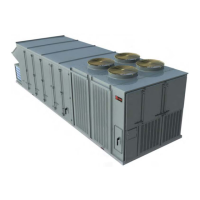
